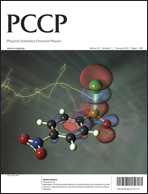Product branching in the photodissociation of oxazole detected by broadband rotational spectroscopy
IF 2.9
3区 化学
Q3 CHEMISTRY, PHYSICAL
引用次数: 0
Abstract
The photodissociation of oxazole (c-C3H3NO) following excitation at 193 nm is studied using mm-Wave rotational spectroscopy in a uniform supersonic flow. Molecules entrained in the flow are excited onto a ππ* state after which it is believed most relax back onto the ground state via ring opening at the O-C[N] bond with subsequent fragmentation. From the line intensities of the probed products, we obtained the branching fractions for seven different products which are the result of five different dissociation pathways. The detected photoproducts and respective branching fractions (%) are the following: HCN (70.4), HCO (22.8), CH2CN (4.2), CH2CO (1.0), CH3CN (1.0), HNC (0.9), HNCO (0.08). We suspect much of the HCO may be formed in conjunction with the isocyanomethyl radical, CH2NC, which we did not probe. We discuss our results in relation to previous work, in particular our own study on the related isomer isoxazole, as well as direct dynamics theoretical simulations from the literature. We also studied the relaxation of a number of vibrationally excited levels of HCN produced at 20 K.通过宽带旋转光谱检测草唑光解过程中的产物分支
在均匀的超音速气流中,使用毫米波旋转光谱法研究了 193 纳米波长激发后恶唑(c-C3H3NO)的光解离。夹带在气流中的分子被激发到 ππ* 态,之后,大多数分子通过 O-C[N] 键处的开环弛豫回到基态,随后发生碎裂。根据探测产物的线强度,我们得到了七种不同产物的分支分数,它们是五种不同解离途径的结果。探测到的光产物和各自的分支分数(%)如下:HCN(70.4)、HCO(22.8)、CH2CN(4.2)、CH2CO(1.0)、CH3CN(1.0)、HNC(0.9)、HNCO(0.08)。我们怀疑大部分 HCO 可能是与异氰基 CH2NC 结合形成的,我们没有对其进行探究。我们将结合以前的工作,特别是我们自己对相关异构体异噁唑的研究,以及文献中的直接动力学理论模拟来讨论我们的结果。我们还研究了 20 K 时产生的 HCN 的一些振动激发水平的弛豫。
本文章由计算机程序翻译,如有差异,请以英文原文为准。
求助全文
约1分钟内获得全文
求助全文
来源期刊

Physical Chemistry Chemical Physics
化学-物理:原子、分子和化学物理
CiteScore
5.50
自引率
9.10%
发文量
2675
审稿时长
2.0 months
期刊介绍:
Physical Chemistry Chemical Physics (PCCP) is an international journal co-owned by 19 physical chemistry and physics societies from around the world. This journal publishes original, cutting-edge research in physical chemistry, chemical physics and biophysical chemistry. To be suitable for publication in PCCP, articles must include significant innovation and/or insight into physical chemistry; this is the most important criterion that reviewers and Editors will judge against when evaluating submissions.
The journal has a broad scope and welcomes contributions spanning experiment, theory, computation and data science. Topical coverage includes spectroscopy, dynamics, kinetics, statistical mechanics, thermodynamics, electrochemistry, catalysis, surface science, quantum mechanics, quantum computing and machine learning. Interdisciplinary research areas such as polymers and soft matter, materials, nanoscience, energy, surfaces/interfaces, and biophysical chemistry are welcomed if they demonstrate significant innovation and/or insight into physical chemistry. Joined experimental/theoretical studies are particularly appreciated when complementary and based on up-to-date approaches.
 求助内容:
求助内容: 应助结果提醒方式:
应助结果提醒方式:


